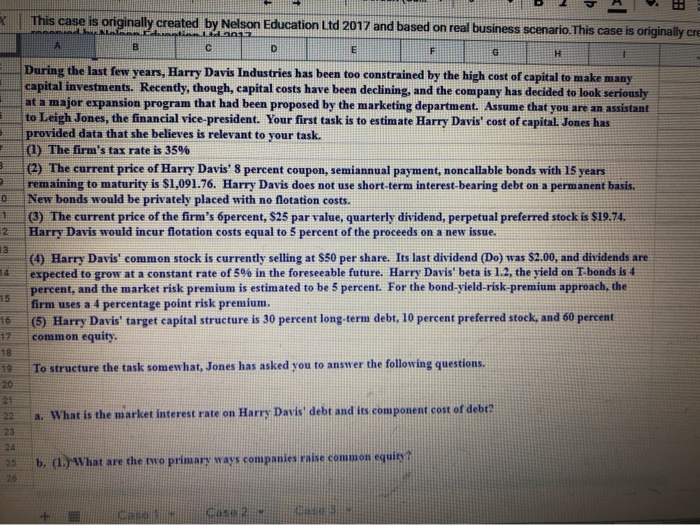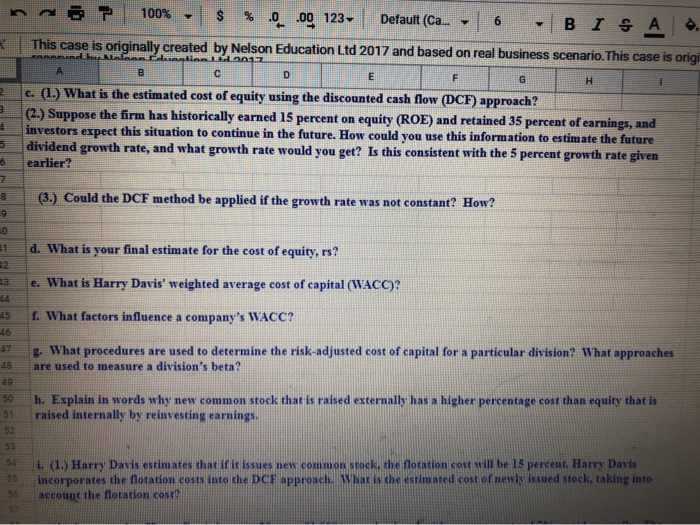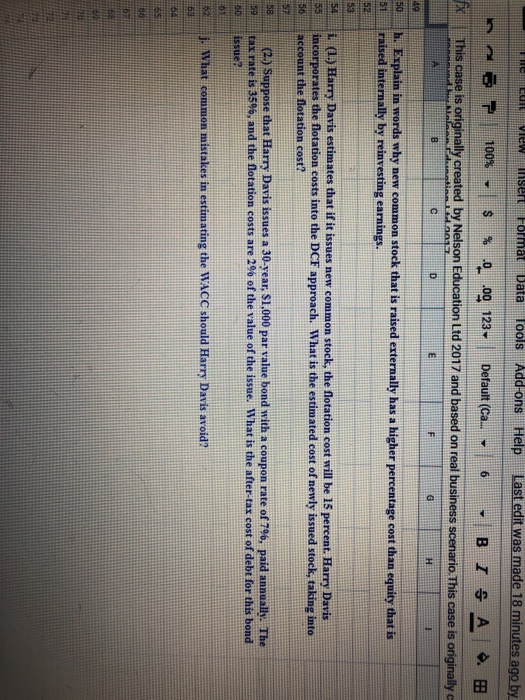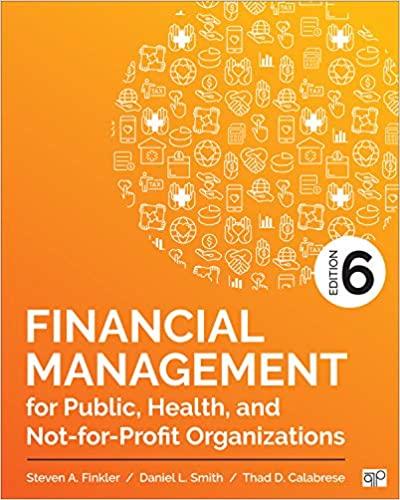2 This case is originally created by Nelson Education Ltd 2017 and based on real business scenario. This case is originally cre 17 A B D F G H E During the last few years, Harry Davis Industries has been too constrained by the high cost of capital to make many capital investments. Recently, though, capital costs have been declining, and the company has decided to look seriously at a major expansion program that had been proposed by the marketing department. Assume that you are an assistant to Leigh Jones, the financial vice-president. Your first task is to estimate Harry Davis' cost of capital. Jones has provided data that she believes is relevant to your task. The firm's tax rate is 35% (2) The current price of Harry Davis' 8 percent coupon, semiannual payment, noncallable bonds with 15 years remaining to maturity is $1,091.76. Harry Davis does not use short-term interest-bearing debt on a permanent basis. New bonds would be privately placed with no flotation costs. (3) The current price of the firm's percent, $25 par value, quarterly dividend, perpetual preferred stock is $19.74. Harry Davis would incur flotation costs equal to 5 percent of the proceeds on a new issue. (4) Harry Davis' common stock is currently selling at $50 per share. Its last dividend (Do) was $2.00, and dividends are expected to grow at a constant rate of 5% in the foreseeable future. Harry Davis' beta is 1.2, the yield on T-bonds is 4 percent, and the market risk premium is estimated to be 5 percent. For the bond-yield-risk-premium approach, the firm uses a 4 percentage point risk premium. (5) Harry Davis' target capital structure is 30 percent long term debt, 10 percent preferred stock, and 60 percent common equity. 2 15 12 To structure the task somewhat, Jones has asked you to answer the following questions, a. What is the market interest rate on Harry Davis' debt and its component cost of debt? 23 24 25 20 b. (1.) What are the two primary ways companies raise common equity Can CO2 100% % . 09123 Default (Ca... - 6 - BIS A. This case is originally created by Nelson Education Ltd 2017 and based on real business scenario. This case is origi B D E F G H 2 3 4 c. (1.) What is the estimated cost of equity using the discounted cash flow (DCF) approach? (2.) Suppose the firm has historically earned 15 percent on equity (ROE) and retained 35 percent of earnings, and investors expect this situation to continue in the future. How could you use this information to estimate the future dividend growth rate, and what growth rate would you get? Is this consistent with the 5 percent growth rate given earlier? 5 5 7 8 (3.) Could the DCF method be applied if the growth rate was not constant? How? 21 2 d. What is your final estimate for the cost of equity, rs? e. What is Harry Davis' weighted average cost of capital (WACC)? 45 f. What factors influence a company's WACC? 46 g. What procedures are used to determine the risk-adjusted cost of capital for a particular division? What approaches are used to measure a division's beta? 48 50 51 52 53 h. Explain in words why new common stock that is raised externally has a higher percentage cost than equity that is raised internally by reinvesting earnings, 55 56 1. (1.) Harry Davis estimates that if it issues new common stock, the flotation cost will be 15 percent. Harry Davis incorporates the flotation costs into the DCF approach. What is the estimated cost of newly issued stock, taking into account the flotation cost? TEUIL VIEW Iseru. Format Data Tools Add-ons Help Last edit was made 18 minutes ago by 100% $ % 0.09 123- Default (Ca. 6 B I = A This case is originally created by Nelson Education Ltd 2017 and based on real business scenario. This case is originally c NAAdanada F B D E G H 49 h. Explain in words why new common stock that is raised externally has a higher percentage cost than equity that is raised internally by reinvesting earnings. 50 51 52 153 54 i. (1.) Harry Davis estimates that if it issues new common stock, the flotation cost will be 15 percent. Harry Davis incorporates the flotation costs into the DCF approach. What is the estimated cost of newly issued stock, taking into account the flotation cost? 55 156 57 58 259 80 (2.) Suppose that Harry Davis issues a 30-year, $1,000 par value bond with a coupon rate of 7%, paid annually. The tax rate is 35%, and the flotation costs are 2% of the value of the issue. What is the after-tax cost of debt for this bond issue? 61 j. What common mistakes in estimating the WACC should Harry Davis avoid? 69 ba 65 156 2 This case is originally created by Nelson Education Ltd 2017 and based on real business scenario. This case is originally cre 17 A B D F G H E During the last few years, Harry Davis Industries has been too constrained by the high cost of capital to make many capital investments. Recently, though, capital costs have been declining, and the company has decided to look seriously at a major expansion program that had been proposed by the marketing department. Assume that you are an assistant to Leigh Jones, the financial vice-president. Your first task is to estimate Harry Davis' cost of capital. Jones has provided data that she believes is relevant to your task. The firm's tax rate is 35% (2) The current price of Harry Davis' 8 percent coupon, semiannual payment, noncallable bonds with 15 years remaining to maturity is $1,091.76. Harry Davis does not use short-term interest-bearing debt on a permanent basis. New bonds would be privately placed with no flotation costs. (3) The current price of the firm's percent, $25 par value, quarterly dividend, perpetual preferred stock is $19.74. Harry Davis would incur flotation costs equal to 5 percent of the proceeds on a new issue. (4) Harry Davis' common stock is currently selling at $50 per share. Its last dividend (Do) was $2.00, and dividends are expected to grow at a constant rate of 5% in the foreseeable future. Harry Davis' beta is 1.2, the yield on T-bonds is 4 percent, and the market risk premium is estimated to be 5 percent. For the bond-yield-risk-premium approach, the firm uses a 4 percentage point risk premium. (5) Harry Davis' target capital structure is 30 percent long term debt, 10 percent preferred stock, and 60 percent common equity. 2 15 12 To structure the task somewhat, Jones has asked you to answer the following questions, a. What is the market interest rate on Harry Davis' debt and its component cost of debt? 23 24 25 20 b. (1.) What are the two primary ways companies raise common equity Can CO2 100% % . 09123 Default (Ca... - 6 - BIS A. This case is originally created by Nelson Education Ltd 2017 and based on real business scenario. This case is origi B D E F G H 2 3 4 c. (1.) What is the estimated cost of equity using the discounted cash flow (DCF) approach? (2.) Suppose the firm has historically earned 15 percent on equity (ROE) and retained 35 percent of earnings, and investors expect this situation to continue in the future. How could you use this information to estimate the future dividend growth rate, and what growth rate would you get? Is this consistent with the 5 percent growth rate given earlier? 5 5 7 8 (3.) Could the DCF method be applied if the growth rate was not constant? How? 21 2 d. What is your final estimate for the cost of equity, rs? e. What is Harry Davis' weighted average cost of capital (WACC)? 45 f. What factors influence a company's WACC? 46 g. What procedures are used to determine the risk-adjusted cost of capital for a particular division? What approaches are used to measure a division's beta? 48 50 51 52 53 h. Explain in words why new common stock that is raised externally has a higher percentage cost than equity that is raised internally by reinvesting earnings, 55 56 1. (1.) Harry Davis estimates that if it issues new common stock, the flotation cost will be 15 percent. Harry Davis incorporates the flotation costs into the DCF approach. What is the estimated cost of newly issued stock, taking into account the flotation cost? TEUIL VIEW Iseru. Format Data Tools Add-ons Help Last edit was made 18 minutes ago by 100% $ % 0.09 123- Default (Ca. 6 B I = A This case is originally created by Nelson Education Ltd 2017 and based on real business scenario. This case is originally c NAAdanada F B D E G H 49 h. Explain in words why new common stock that is raised externally has a higher percentage cost than equity that is raised internally by reinvesting earnings. 50 51 52 153 54 i. (1.) Harry Davis estimates that if it issues new common stock, the flotation cost will be 15 percent. Harry Davis incorporates the flotation costs into the DCF approach. What is the estimated cost of newly issued stock, taking into account the flotation cost? 55 156 57 58 259 80 (2.) Suppose that Harry Davis issues a 30-year, $1,000 par value bond with a coupon rate of 7%, paid annually. The tax rate is 35%, and the flotation costs are 2% of the value of the issue. What is the after-tax cost of debt for this bond issue? 61 j. What common mistakes in estimating the WACC should Harry Davis avoid? 69 ba 65 156









